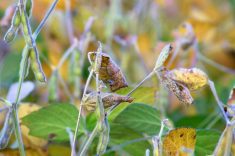Soybeans arrived in Manitoba in the early 20th century, but it took another 100 years for them to become a major crop. Now, almost two decades into the 21st century, an old enemy from the homeland has finally followed.
Soybean cyst nematode (SCN) is already a serious pest in the soybean belt of the American Midwest.
It is believed to have originated in Asia, where soybeans also originated, according to plant pathologist Greg Tylka of Iowa State University.
Read Also

When farmers vote against their interests
U.S president Donald Trump has left many clues over the years that many of his actions weren’t going to necessarily be in the best interests of American farmers.
Why it matters: The microscopic parasites have been known to reduce yields by more than 30 per cent in the U.S., but above-ground symptoms are not always obvious, which can hinder critical early detection.
Most crop species are imported from other parts of the world and it’s typical for their tormentors to follow.
Since its North American debut on the coast of North Carolina in 1954, SCN has moved through Minnesota and the Dakotas. Now it’s poking its head over the border into southern Manitoba.
The nematode is “among the most damaging of plant parasitic nematodes,” Tylka said. “Its name alludes to the fact that its primary host is soybean, but it also can feed on edible beans of various types.”
[RELATED] Tracing roots for a strategy against soybean cyst nematode
Nematodes are sometimes called roundworms. It’s not clear how many species there are but thousands have been counted to date. Diverse in habitats and tastes, quite a few feed on plants and several find common Canadian crop species to their liking.
“There’s a couple of different ones that like potatoes,” Tylka said. “One is called the pale cyst nematode and another one is called the golden cyst nematode. There are cyst nematodes on carrot and sugar beet and a bunch of different things.”
Their biology can make them serious pests. SCN lives in the soil where it cuts its way into the plant’s root tissue.
“The little worm gets inside the root and injects something into the vascular tissue of the plant,” Tylka said. “This actually changes the biology of those plant cells and they start producing food for the nematode. It’s fascinating.”
That means the plant is using some of its energy to make a custom meal for the worm rather than growing its own tissue or filling pods. One invading nematode won’t dent bean production, but a big enough infestation can seriously weaken plants.
It doesn’t stop there, either.
The name “cyst nematode” reveals something about how it spreads. Males and females invade the root and set up feeding sites. The female grows large and, although its head remains in the root, its body erupts into the soil.
The males, having eaten their fill, move out of the root and mate with the females. Some eggs are then dropped into the soil in a gelatinous sack, but most are kept within the female’s body.
“When she dies, her body wall becomes very tough and leathery to protect those eggs and that’s what’s called a cyst,” Tylka said.
That cyst female is about the size of a period and contains 200 to 250 eggs.
It takes about 22 days to evolve from root invasion to egg production, so there’s a chance for several generations per season.
Eggs that don’t hatch immediately can remain viable in the cyst for several years. If they are in the topsoil, wind can spread them to nearby fields. The ability of the eggs to endure and travel makes them a serious problem.
“It’s a wonderful survival mechanism to have a large proportion of your population not become vulnerable while it’s reproducing all at once in the short term,” Tylka said.
In some cases, soil moisture seems to stimulate hatching. Some need to sense root exudate, the “juice” from a soybean root, so they know a host is nearby.
“Then there’s a third type of egg that doesn’t hatch no matter what we do in an experiment,” Tylka said. “There’s those three hatching behaviours, probably all occurring in one set of eggs in one dead female or cyst.”
That doesn’t mean they never hatch, the researcher cautioned. It just means the trigger isn’t known.
Allowing dormant eggs to hunker down for the long haul can explain why the ancestors of current crop pests were successful. In a wild ecosystem, an annual host plant would be a relative rarity.
Rotate, rotate, rotate
A tight rotation provides the perfect environment for nematodes to reproduce.
“Field research has shown that you can get up to a 50 percent drop in SCN numbers in one year of corn, which roughly means that 50 percent of the eggs hatched out and died off,” Tylka said.
SCN is estimated to cost about $1.5 billion in losses every year in North America, sparking a wealth of management research in hard-hit areas of the U.S.
“Most good ideas and even some cockamamie ideas have been thoroughly explored and it’s just a tough critter,” Tylka said. “Mother Nature came up with a good one when she developed cyst nematodes, so the management is resistance (and) rotating to non-host crops.”
There are seed treatments on the market, the researcher said, but actual control is hit or miss.















